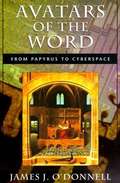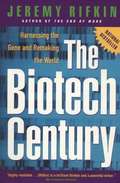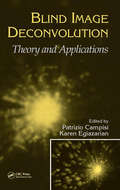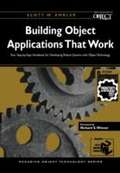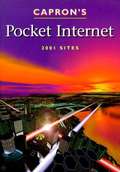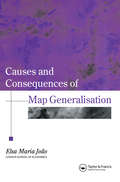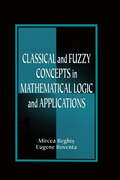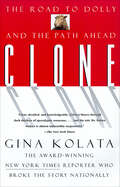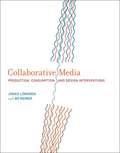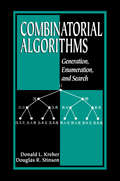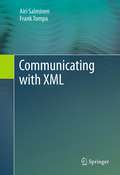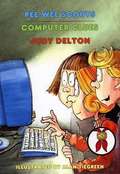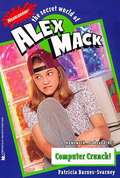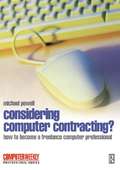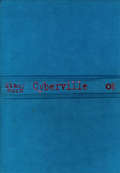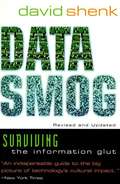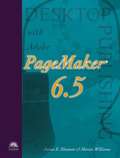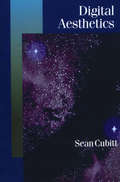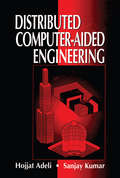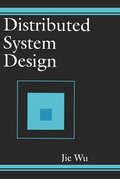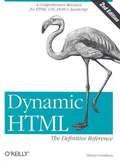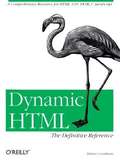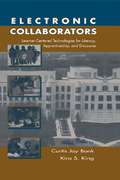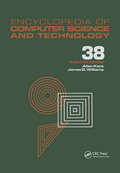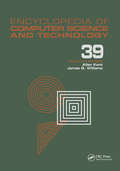- Table View
- List View
Avatars of the Word: From Papyrus to Cyberspace
by James J. O'DonnellConsiders the future of the printed word given the growth of electronic communication as a modern medium for information and culture. In investigating past cultural transitions, such as from the spoken to the written word, or from manuscript to the printing press, O'Donnell (classical studies, U. of Pennsylvania) reveals the contemporary crossroads between media as contiguous with the history of communication. Annotation c. by Book News, Inc. , Portland, Or.
The Biotech Century: Harnessing the Gene and Remaking the World
by Jeremy RifkinIn this seminal book, Jeremy Rifkin explores the epic marriage between computer technology and genetic engineering, and the historic transition into the Age of Biotechnology. Already, Rifkin explains, our economy is undergoing a massive shift away from the Industrial Age and into an era in which giant life-science corporations are fashioning a bioindustrial world. Humanity is on the brink of wielding greater control over the shape of life--how we are born; how our food supply is created; the traits our children may have--than has ever been imagined. But with each step into this new era, we must ask ourselves: At what cost?
Blind Image Deconvolution: Theory and Applications
by Patrizio Campisi Karen EgiazarianBlind image deconvolution is constantly receiving increasing attention from the academic as well the industrial world due to both its theoretical and practical implications. The field of blind image deconvolution has several applications in different areas such as image restoration, microscopy, medical imaging, biological imaging, remote sensing, astronomy, nondestructive testing, geophysical prospecting, and many others. Blind Image Deconvolution: Theory and Applications surveys the current state of research and practice as presented by the most recognized experts in the field, thus filling a gap in the available literature on blind image deconvolution.Explore the gamut of blind image deconvolution approaches and algorithms that currently exist and follow the current research trends into the future. This comprehensive treatise discusses Bayesian techniques, single- and multi-channel methods, adaptive and multi-frame techniques, and a host of applications to multimedia processing, astronomy, remote sensing imagery, and medical and biological imaging at the whole-body, small-part, and cellular levels. Everything you need to step into this dynamic field is at your fingertips in this unique, self-contained masterwork.For image enhancement and restoration without a priori information, turn to Blind Image Deconvolution: Theory and Applications for the knowledge and techniques you need to tackle real-world problems.
Building Object Applications That Work: Your Step-by-Step Handbook for Developing Robust Systems with Object Technology
by Scott W. AmblerA must-have resource for designers and testers of today's OO applications, the book takes you thru the entire process of building object applications.
Capron's Pocket Internet 2001 Sites
by H. L. CapronWant to find the best sites on the Net for your topic of interest? More than 2000 carefully selected websites so start discovering!
Causes And Consequences Of Map Generalization
by Elsa JoaoThis text describes late-1990s understanding of map generalisation in the context of paper maps and GIS. Its particular value should be in helping to further automate and measure the process of map generalisation.; The research has concentrated on quantifying generalisation effects and on analysing how these effects of generalisation locked into the maps were measured. Elsa Joao's book covers the background to the problems of map generlasation; the methodology developed by the author to investigate the consequences of the map generalisation; a detailed description of results, and a conclusion that draws together consequences for the broader applications to GIS.
Classical and Fuzzy Concepts in Mathematical Logic and Applications, Professional Version
by Mircea S. Reghis Eugene RoventaClassical and Fuzzy Concepts in Mathematical Logic and Applications provides a broad, thorough coverage of the fundamentals of two-valued logic, multivalued logic, and fuzzy logic.Exploring the parallels between classical and fuzzy mathematical logic, the book examines the use of logic in computer science, addresses questions in automatic deduction, and describes efficient computer implementation of proof techniques.Specific issues discussed include:Propositional and predicate logicLogic networksLogic programmingProof of correctnessSemanticsSyntaxCompletenesssNon-contradictionTheorems of Herbrand and KalmanThe authors consider that the teaching of logic for computer science is biased by the absence of motivations, comments, relevant and convincing examples, graphic aids, and the use of color to distinguish language and metalanguage. Classical and Fuzzy Concepts in Mathematical Logic and Applications discusses how the presence of these facts trigger a stirring, decisive insight into the understanding process. This view shapes this work, reflecting the authors' subjective balance between the scientific and pedagogic components of the textbook.Usually, problems in logic lack relevance, creating a gap between classroom learning and applications to real-life problems. The book includes a variety of application-oriented problems at the end of almost every section, including programming problems in PROLOG III. With the possibility of carrying out proofs with PROLOG III and other software packages, readers will gain a first-hand experience and thus a deeper understanding of the idea of formal proof.
Clone: The Road To Dolly, And The Path Ahead
by Gina KolataThe birth of Dolly -- the world's first clone -- placed in our hands the secret of creation. Few discoveries have so altered our notion of what it means to be human, or presented such a Gordian knot of ethical, spiritual, and scientific questions. Noted science journalist Gina Kolata broke the news nationally in The New York Times and was the first reporter to speak with Dr. Ian Wilmut, the embryologist who cloned Dolly. Now Kolata reveals the story behind Dolly, interweaving the social and cultural tales of our fear and fascination with cloning, reaching back nearly a century, with the riveting scientific accountof how a clone came to be and the mind-boggling questions Dolly presents for our future.Clone is a compelling blend of scientific suspense, dreams dashed, and frauds exposed, with provocative philosophical questions and an astute assessment of why Dolly's birth was only possible now. Like The Making of the Atomic Bomb, Lucy, and Chaos, this book gives us a window on history in the making, and an understanding of its profound effect on our lives.
Collaborative Media: Production, Consumption, and Design Interventions
by Jonas Löwgren Bo ReimerWith many new forms of digital media--including such popular social media as Facebook, Twitter, and Flickr -- the people formerly known as the audience no longer only consume but also produce and even design media. Jonas L'wgren and Bo Reimer term this phenomenon collaborative media, and in this book they investigate the qualities and characteristics of these forms of media in terms of what they enable people to do. They do so through an interdisciplinary research approach that combines the social sciences and humanities traditions of empirical and theoretical work with practice-based, design-oriented interventions. L'wgren and Reimer offer analysis and a series of illuminating case studies -- examples of projects in collaborative media that range from small multidisciplinary research experiments to commercial projects used by millions of people. L'wgren and Reimer discuss the case studies at three levels of analysis: society and the role of collaborative media in societal change; institutions and the relationship of collaborative media with established media structures; and tribes, the nurturing of small communities within a large technical infrastructure. They conclude by advocating an interventionist turn within social analysis and media design.
Combinatorial Algorithms: Generation, Enumeration, and Search (Discrete Mathematics And Its Applications Ser. #7)
by Donald L. Kreher Douglas R. StinsonThis textbook thoroughly outlines combinatorial algorithms for generation, enumeration, and search. Topics include backtracking and heuristic search methods applied to various combinatorial structures, such as:CombinationsPermutationsGraphsDesignsMany classical areas are covered as well as new research topics not included in most existing texts, such as:Group algorithmsGraph isomorphismHill-climbingHeuristic search algorithmsThis work serves as an exceptional textbook for a modern course in combinatorial algorithms, providing a unified and focused collection of recent topics of interest in the area. The authors, synthesizing material that can only be found scattered through many different sources, introduce the most important combinatorial algorithmic techniques - thus creating an accessible, comprehensive text that students of mathematics, electrical engineering, and computer science can understand without needing a prior course on combinatorics.
Communicating with XML
by Airi Salminen Frank TompaThis book provides extensive insight into the possibilities and challenges of XML in building new information management solutions in networked organizations. After a brief introduction to Web communication features and XML fundamentals, the book examines the benefits of adopting XML and illustrates various types of XML use: XML in document management; XML for data-centric and multimedia components; XML as a format for metadata, including metadata for the Semantic Web; and XML in support of data interchange between software applications and among organizations. The challenges of adopting XML in large-scale information management are also discussed. In addition, applications across a broad spectrum are examined and numerous case studies pertaining to the adoption of XML are presented. The book is particularly suitable for courses offered in Information Studies, Information Systems, or Information Technology. It also serves as an excellent practical guide for professionals in information management and provides important support material for courses in Computer Science and in Business.
Computer Clues (Pee Wee Scouts #36)
by Judy DeltonThe Pee Wees are entering cyberspace! The scouts are earning their computer badges, and that means lots of fun--and lots of surprises--are in store. From surfing the Web to sending e-mail to going on a cyber treasure hunt, the online adventures keep getting better and better. And when Molly receives an e-mail message from a secret admirer, she and Mary Beth have an exciting computer mystery to solve. The Pee Wees goof around, do good deeds, take on projects and have fun and adventures. Find out all about what scouts do in the other 38 Pee Wee Scout books you can get from Bookshare including: #1 Cookies and Crutches, #2 Camp Ghost-Away, #3 Lucky Dog Days, #4 Blue Skies, French Fries, #5 Grumpy Pumpkins, #6 Peanut-Butter Pilgrims, #7 A Pee Wee Christmas, #8 That Mushy Stuff, #9 Spring Sprouts, #10 The Pooped Troop, # 11 The Pee Wee Jubilee, #12 Bad, Bad, Bunnies, #13 Rosy Noses, Frozen Toes, #14 Sonny's Secret, #15 Sky Babies, #16 Trash Bash, # 17 Pee Wees On Parade, #18 Lights, Action, Land-ho!, # 19 Piles of Pets, #20 Fishy Wishes, #21 Pee Wees On skis, #22 Greedy Groundhogs, #23 All Dads on Deck, #24 Tricks and Treats, #25 Pee Wees on First, # 26 Super Duper Pee Wees, #27 Teeny Weeny Zucchinis, #28 Eggs With Legs, #29 Pee Wee Pool Party, #30 Bookworm Buddies, #31 Moans and Groans and Dinosaur Bones, #32 Stage Frightened, #33 Halloween Helpers, #34 Planet Pee Wee, #35 Pedal Power, #37 Wild, Wild West, #38 Here Come the Clowns, and #39 Molly For Mayor.
Computer Crunch! (The Secret World of Alex Mack #24)
by Patricia L. Barnes-SvarneyAlex's media class is divided into two teams and both are assigned to write a newsletter. The other team is way ahead of her group and she begins to smell a rat--is there a traitor in her midst?
Considering Computer Contracting?: The Computer Weekly Guide To Becoming A Freelance Computer Professional (Computer Weekly Professional Ser.)
by Michael PowellConsidering computer contracting?If you are, then read this book. It explores the many aspects of the computer contracting world and gives sound practical advice to both the newcomer and the experienced contractor. It will also be invaluable if you are an employer wrestling with the perennial problem of finding staff in this highly competitive marketplace.Let this book show you how to break loose from being an employee to working freelance. The author, a freelancer himself, considers what it takes to become a contract worker and gives you invaluable information throughout to help you get started in the world of computer contracting. This book looks at:* why contract workers are used at all - what kind of companies actually employ contractors, and why?* how you make the transition from full-time working - what does it actually take temperamentally to be a successful contractor?* how you start - what does forming your own company involve, and why is it even necessary?* how you go about finding a contract, and negotiating the right rate.* what agencies do for you - and how can you find who are the best?* the financial differences between being a full-time employee and a contractor - how do you manage your affairs?* how you keep your experience up to date when you do not have a regular employer to help train you.* what sort of opportunities are available, and what sort of rates of pay you can expect.* your possible career progressions after contracting.The contracting scene is ever changing. In this wide-ranging book, the current outlook for contract staff is analysed as well as the trends in the computer industry which are driving these changes. Some doors are opening whilst other close - let this book be your guide.If you have marketable skills, the right attitude and would like to be your own boss, there could not be a better time to consider computer contracting.
Cyberville: Clicks, Culture, and the Creation of an Online Town
by Stacy HornA look at ECHO, one of the original on-line communities.
Data Smog
by David ShenkMedia scholar ( and Internet Enthusiast ) David Shenk examines the troubling effects of information proliferation on our bodies, our brains, our relationships, and our culture, then offers strikingly down-to-earth insights for coping with the deluge. With a skillful mixture of personal essay, firsthand reportage, and sharp analysis, Shenk illustrates the central paradox of our time: as our world gets more complex, our responses to it become increasingly simplistic. He draws convincing links between data smog and stress distraction, indecision, cultural fragmentation, social vulgarity, and more. But there's hope for a saner, more meaningful future, as Shenk offers a wealth of novel prescriptions-both personal and societal-for dispelling data smog.
Desktop Publishing with Adobe Pagemaker 6.5 for Windows
by James E. Shuman Marcia WilliamsDesigned for use in front of the computer, this spiral-bound text offers a top down approach, showing students the completed project first, then leading them through its creation.
Digital Aesthetics (Published in association with Theory, Culture & Society)
by Sean CubittThis book investigates the aesthetic nature and purpose of computer culture in the contemporary world. It casts a cool eye on the claims of cybertopians, tracing the globalization of the new medium and enquiring into its effects on subjectivity and sociality. Drawing on historical scholarship, philosophical aesthetics, and the literature of cyberculture, the author argues for a genuine democracy beyond the limitations of the free market and the global corporation. Digital arts are identified as having a vital part to play in this process. Written in a balanced and penetrating style, the book both conveniently summarizes a huge literature and sets a new agenda for research and theory. Copyright © Libri GmbH. All rights reserved.
Distributed Computer-Aided Engineering
by Hojjat Adeli Sanjay KumarNetworking of personal computers and workstations is becoming commonplace in academic and industrial environments. A cluster of workstations provides engineers with a familiar, cost-effective environment for high performance computing. However, workstations often have no dedicated link and communicate slowly on a local area network (LAN), such as the Ethernet. Thus, to effectively harness the parallel processing or distributed computing capabilities of workstations, new algorithms need to be developed with a higher computation-to-communication ratio.Distributed Computer-Aided Engineering presents distributed algorithms for three fundamental areas: finite element analysis, design optimization, and visualization - providing a new direction in high performance structural engineering computing.
Distributed System Design
by Jie WuFuture requirements for computing speed, system reliability, and cost-effectiveness entail the development of alternative computers to replace the traditional von Neumann organization. As computing networks come into being, one of the latest dreams is now possible - distributed computing. Distributed computing brings transparent access to as much computer power and data as the user needs for accomplishing any given task - simultaneously achieving high performance and reliability.The subject of distributed computing is diverse, and many researchers are investigating various issues concerning the structure of hardware and the design of distributed software. Distributed System Design defines a distributed system as one that looks to its users like an ordinary system, but runs on a set of autonomous processing elements (PEs) where each PE has a separate physical memory space and the message transmission delay is not negligible. With close cooperation among these PEs, the system supports an arbitrary number of processes and dynamic extensions.Distributed System Design outlines the main motivations for building a distributed system, including:inherently distributed applicationsperformance/costresource sharingflexibility and extendibilityavailability and fault tolerancescalabilityPresenting basic concepts, problems, and possible solutions, this reference serves graduate students in distributed system design as well as computer professionals analyzing and designing distributed/open/parallel systems.Chapters discuss:the scope of distributed computing systemsgeneral distributed programming languages and a CSP-like distributed control description language (DCDL)expressing parallelism, interprocess communication and synchronization, and fault-tolerant designtwo approaches describing a distributed system: the time-space view and the interleaving viewmutual exclusion and related issues, including election, bidding, and self-stabilizationprevention and detection of deadlockreliability, safety, and security as well as various methods of handling node, communication, Byzantine, and software faultsefficient interprocessor communication mechanisms as well as these mechanisms without specific constraints, such as adaptiveness, deadlock-freedom, and fault-tolerancevirtual channels and virtual networksload distribution problemssynchronization of access to shared data while supporting a high degree of concurrency
Dynamic HTML: The Definitive Reference, 2nd Edition
by Danny GoodmanDynamic HTML: The Definitive Reference, 2nd Edition, is an indispensable compendium for web development. The new edition has been updated to include complete reference material on the latest specifications, including HTML 4.01, CSS Level 2, DOM Level 2, and JavaScript 1.5, as well as the latest browsers, Internet Explorer 6 (Windows), Internet Explorer 5.1 (Mac), Netscape Navigator 6 and 7, and Mozilla 1.0.
Dynamic HTML: The Definitive Reference
by Danny GoodmanIf you are a Web content developer these days, you have a lot of information to keep track of. You need to stay current on the relevant Web specifications, like HTML, CSS, DOM, and ECMAScript. You also need to know how the latest Web browsers from Netscape and Microsoft actually implement these standards, since browser implementations of the standards are less than perfect. Right now, you're forced to keep multiple reference books open on your desk (or multiple browser windows open on your screen), just to develop a simple dynamic Web page that works properly under both Navigator and Internet Explorer. Dynamic HTML: The Definitive Reference changes all that. This book is an indispensable compendium for Web content developers. It contains everything you need to create functional cross-platform Web applications, including: A complete reference for all of the HTML tags, CSS style attributes, browser document objects, and JavaScript objects supported by the various standards and the latest versions of Navigator and Internet Explorer. Browser compatibility is emphasized throughout; the reference pages clearly indicate browser support for every entity. Handy cross-reference indexes that make it easy to find interrelated HTML tags, style attributes, and document objects. An advanced introduction to creating dynamic Web content that addresses the cross-platform compromises inherent in Web page design today. If you have some experience with basic Web page creation, but are new to the world of dynamic content, Dynamic HTML: The Definitive Reference will jump-start your development efforts. If you are an experienced Web programmer, you'll find the browser-compatibility information invaluable. This book is the only DHTML reference that a Web developer needs. Dynamic HTML: The Definitive Reference is designed to work in conjunction with HTML: The Definitive Guide and JavaScript: The Definitive Guide . HTML: The Definitive Guide teaches you about every element of HTML in detail, with explanations of how each element works and how it interacts with other elements, as well as numerous examples. JavaScript: The Definitive Guide provides a thorough description of the JavaScript language, complete with sophisticated examples that show you how to handle common Web application tasks. Together, these three books provide a complete library for Web content developers.
Electronic Collaborators: Learner-centered Technologies for Literacy, Apprenticeship, and Discourse
by Curtis Jay Bonk Kira S. KingTwo developments in recent years have converged to dramatically alter most conceptions of the teaching and learning process. First, technology has become increasingly interactive and distributed, such that individual learners have available the means to participate in incredibly complex networks of information, resources, and instruction. As these technological advancements facilitate interaction across classroom, university, and worldwide learning communities in both real-time and delayed formats, various instructional design and implementation problems spring forth. Second, the conventional teacher-centered model wherein knowledge is transmitted from the teacher to the learner is being replaced by social constructivist and learner-centered models of instruction. These new learner-centered models place emphasis on guiding and supporting students as they meaningfully construct their understanding of various cultures and communities. As a consequence of these developments, teachers need guidelines from educational researchers about integrating collaboration and communication tools into their classrooms. This volume presents research on such collaborative technology as it facilitates, augments, and redefines academic learning environments. The studies illustrate how schools, teachers, and students are discovering, employing, and modifying the numerous new computer conferencing and collaborating writing tasks and tools, and their effects on social interaction and resulting student learning. Documentation is given that will help teachers to make decisions that productively transform learning environments. Three key objectives underlie this volume: *to discover some of the electronic collaboration tools and formats currently employed by teachers in schools and universities and to situate these within a five-level taxonomy of computer conferencing and collaborative writing tools and approaches; *to examine some of the sociocultural learning variables embedded in the use of electronic collaborative tools and approaches; and *to participate in a dialogue about the importance of student electronic social interaction and dialogue from a sociocultural perspective. This is a must-read volume for all researchers, scholars, graduate students, and practitioners interested in such fields as sociocultural theory, process writing, cooperative learning, learner-centeredness, distance education, peer conferencing and tutoring, mentoring, electronic collaboration, problem- and project-based learning, collaborative writing, and educational reform.
Encyclopedia of Computer Science and Technology: Volume 38 - Supplement 23: Algorithms for Designing Multimedia Storage Servers to Models and Architectures (Computer Science And Technology Encyclopedia Ser.)
by Allen KentVolume 38 - Supplement 23: Algorithms for Designing Multimedia Storage Servers to Models and Architectures. Covering more than basic computer commands and procedures, this encyclopaedia summarizes how technology has developed, the future of computer programs and applications, and the significance of computer components. Following an introduction and overview, there are approximately 750 to 800 entries.
Encyclopedia of Computer Science and Technology: Volume 39 - Supplement 24 - Entity Identification to Virtual Reality in Driving Simulation
by Allen KentVolume 39 - Supplement 24 - Entity Identification to Virtual Reality in Driving Simulation. Covering more than basic computer commands and procedures, this encyclopaedia summarizes how technology has developed, the future of computer programs and applications, and the significance of computer components. Following an introduction and overview, there are approximately 750 to 800 entries.
